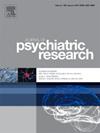Identifying the association of hyperarousal and insomnia symptoms: A network perspective
IF 3.7
2区 医学
Q1 PSYCHIATRY
引用次数: 0
Abstract
Objective
Insomnia, a prevalent public health problem, is characterized by hyperarousal; however, evidence on the comparison of associations between insomnia symptoms and different forms of arousal is limited. This study utilizes network analysis to explore the complex associations between insomnia symptoms and hyperarousal and to identify key symptoms.
Methods
A total of 1209 participants with non-clinical sleep disorders were included in the study. Hyperarousal was assessed by the Arousal Predisposition Scale (APS) and the Pre-sleep Arousal Scale (PSAS), which encompasses two forms of state arousal (pre-sleep cognitive/somatic arousal). Insomnia symptoms were assessed by Pittsburgh Sleep Quality Index (PSQI). Gaussian graph networks and directed acyclic graphs (DAG) were applied to examine associations between variables and identify key variables.
Results
Pre-sleep cognitive arousal is the most important variable in the Gaussian network, acting as a “bridge” between the insomnia symptoms and hyperarousal domains, and serving as the gateway that activates most of the insomnia symptoms and hyperarousal in the DAG. Subjective sleep duration is another key driver in the DAG, marking the starting point for insomnia symptoms, while the use of sleep medication represents the endpoint of the pathway.
Conclusion
All forms of hyperarousal are positively associated with insomnia symptoms, and pre-sleep cognitive arousal plays the most important role in the maintenance and activation of the insomnia symptoms-hyperarousal network.
识别过度觉醒和失眠症状的关联:一个网络视角
目的:失眠是一个普遍的公共卫生问题,其特征是过度觉醒;然而,关于失眠症状和不同唤醒形式之间的关联比较的证据是有限的。本研究利用网络分析探讨失眠症状与过度觉醒之间的复杂关联,并找出关键症状。方法共纳入1209例非临床睡眠障碍患者。过度觉醒由唤醒倾向量表(APS)和睡眠前唤醒量表(PSAS)评估,其中包括两种状态唤醒(睡眠前认知唤醒/躯体唤醒)。采用匹兹堡睡眠质量指数(PSQI)评估失眠症状。应用高斯图网络和有向无环图(DAG)来检查变量之间的关联并识别关键变量。结果睡眠前认知觉醒是高斯网络中最重要的变量,是失眠症状和高唤醒域之间的“桥梁”,是激活DAG中大部分失眠症状和高唤醒的门户。主观睡眠时间是DAG的另一个关键驱动因素,它标志着失眠症状的起点,而睡眠药物的使用代表了该途径的终点。结论所有形式的高唤醒均与失眠症状呈正相关,其中睡前认知唤醒在失眠症状-高唤醒网络的维持和激活中起着最重要的作用。
本文章由计算机程序翻译,如有差异,请以英文原文为准。
求助全文
约1分钟内获得全文
求助全文
来源期刊

Journal of psychiatric research
医学-精神病学
CiteScore
7.30
自引率
2.10%
发文量
622
审稿时长
130 days
期刊介绍:
Founded in 1961 to report on the latest work in psychiatry and cognate disciplines, the Journal of Psychiatric Research is dedicated to innovative and timely studies of four important areas of research:
(1) clinical studies of all disciplines relating to psychiatric illness, as well as normal human behaviour, including biochemical, physiological, genetic, environmental, social, psychological and epidemiological factors;
(2) basic studies pertaining to psychiatry in such fields as neuropsychopharmacology, neuroendocrinology, electrophysiology, genetics, experimental psychology and epidemiology;
(3) the growing application of clinical laboratory techniques in psychiatry, including imagery and spectroscopy of the brain, molecular biology and computer sciences;
 求助内容:
求助内容: 应助结果提醒方式:
应助结果提醒方式:


